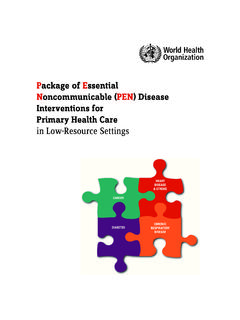Transcription of Integrating Behavioral Health & Primary Care in …
1 December 2016 Integrating Behavioral Health & Primary care in New Hampshire: A Path Forward to Sustainable Practice & Payment TransformationACKNOWLEDGEMENTSThe New Hampshire Citizens Health Initiative would like to thank Co-Chairs Sharon Beaty and Jos Their Montero, the Leadership Advisory Board and Clinical Advisory Committee, Learning Collaborative participants, funders, consulting colleagues, and staff at the Initiative, and the University of New Hampshire Institute for Health Policy and Practice and its Center for Health Analytics for all of their contributions that have made the NH Behavioral Health Integration Learning Collaborative possible. CONTRIBUTORSC onsultants James Highland, PhD, Compass Health AnalyticsPatrick Miller, MPH, Pero Consulting Group, LLCS taffNew Hampshire Citizens Health Initiative Institute for Health Policy and Practice Jeanne Ryer, MScLucy Hodder, JDMarcy Doyle, RN, MHA, MSHwasun GarinMolly O NeilHolly Deblois Tutko, MScJo Porter, MPHS tephanie Cameron, MPH Janet Thomas, RN, BS ADVISORY COMMITTEEW illiam Brewster, MDDavid Coursin, MDDoris Lotz, MDJose Montero, MD, MHCDSS haron Beaty, MBA, FACMPEY vonne Goldsberry, PhDAlexander Blount, EdDAmy Pepin, MSW, LCSW, CPSW illiam Gunn, PhDLisa Bujno, MSN, APRNS tephen J.
2 Bartels, MD, MScSusan Nichols, PA-CFUNDERSE ndowment for Health New Hampshire Charitable FoundationWe especially want to thank Kim Firth, Yvonne Goldsberry, Tym Rourke, and Deborah Schachter for their vision and leadership on these important 2016 University of New Hampshire. All rights reserved. This publication may be reproduced in its entirety and distributed with attribution. Suggested Citation: Ryer, J., Highland, J., Hodder, L., Miller, P., Doyle, M., Garin, H., .. Thomas, J. (2016). Integrating Behavioral Health and Primary care in New Hampshire: A path forward to sustainable practice and payment. A preliminary report (White Paper). Concord NH: New Hampshire Citizens Health InitiativeContentsExecutive Summary iiIntroduction 1 Review of Literature and Evidence-Based Practice 2 Background: Planning a New Hampshire Response 3 BHI Learning Collaborative Structure and Process 4 Learning Collaborative Sessions 4 Facilitated Discussions 4 Implementation Projects 4 Payment Model 5 Evaluation 5 Early Results 5 Learning Collaborative Sessions 5 Facilitated Discussions: Options and Barriers to Integrated care 5 Implementation Projects 6 Payment Model 8 Summary: Barriers to Behavioral Health Integration and Opportunities for Progress 13 Workforce 13 Payment 15 Privacy and Confidentiality 16 Health Information Technology 16 Conclusion 18 Citations 19 Appendices 22 Appendix A: NH BHI Learning Collaborative Learning Sessions and Topics 22 Appendix B: NH BHI Learning Collaborative Participants 23 Appendix C.
3 Current Fee-For-Service Billing Codes & Coverage Identified by Depression + Chronic Work Group as of December 2015 24 Appendix D: Facilitating Behavioral Health Integration through a Quality Improvement Learning Network 30iExecutive SummaryNew Hampshire residents face challenges with Behavioral and physical Health conditions and the interplay between them. National studies show the costs and the burden of illness from Behavioral Health conditions and co-occurring chronic Health conditions that are not adequately treated in either Primary care or Behavioral Health settings. Bringing Primary Health and Behavioral Health care together in integrated care settings can improve outcomes for both Behavioral and physical Health con-ditions. Primary care integrated Behavioral Health works in conjunction with specialty Behavioral Health providers, expand-ing capacity, improving access, and jointly managing the care of patients with higher levels of its work to improve the Health of NH residents and create effective and cost-effective systems of care , the NH Citizens Health Initiative (Initiative) created the NH Behavioral Health Integration Learning Collaborative (BHI Learning Collabora-tive) in November of 2015, as a project of its Accountable care Learning Network (NHACLN).
4 Bringing together more than 60 organizations, including providers of all types and sizes, all of the state s community mental Health centers, all of the major private and public insurers, and government and other stakeholders, the BHI Learning Collaborative built on earlier work of a NHACLN Workgroup focused on improving care for depression and co-occurring chronic illness. The BHI Learning Collaborative design is based on the core NHACLN philosophy of shared data and shared learning and the importance of transparency and open conversation across all stakeholder first year of the BHI Learning Collaborative programming included shared learning on evidence-based practice for integrated Behavioral Health in Primary care , shared data from the NH Comprehensive Healthcare Information System (NHCHIS), and work to develop sustainable payment models to replace inadequate Fee-for-Service (FFS) revenues. Provider members joined either a Project Implementation Track working on quality improvement projects to improve their levels of integration or a Listen and Learn Track for those just learning about Behavioral Health Integration (BHI).
5 Providers in the Project Implementation Track completed a self-assessment of levels of BHI in their practice settings and committed to submit EHR-based clinical process and outcomes data to track performance on specified measures. All providers received access to unblinded NHACLN Primary care and Behavioral Health attributed claims data from the NHCHIS for provider organiza-tions in the NH BHI Learning Collaborative. Following up on prior work focused on developing a sustainable model for Integrating care for depression and co-occurring chronic illness in Primary care settings, the BHI Learning Collaborative engaged consulting experts and participants in un-derstanding challenges in Health Information Technology and Exchange (HIT/HIE), privacy and confidentiality, and work-force adequacy. The BHI Learning Collaborative identified a sustainable payment model for integrated care of depression in Primary care .
6 In the process of vetting the payment model, the BHI Learning Collaborative also identified and explored challenges in payment for Substance Use Disorder Screening, Brief Intervention and Referral to Treatment (SBIRT).New Hampshire s residents will benefit from a Health care system where Primary care and Behavioral Health are integrated to support the care of the whole person. New Hampshire s current opiate epidemic accentuates the need for better screening for Behavioral Health issues, prevention, and treatment referral integrated into Primary care . New Hampshire providers and payers are poised to move towards greater integration of Behavioral Health and Primary care and the Initiative looks forward to continuing to support progress in supporting a path to sustainable integrated Behavioral and Primary Behavioral Health & Primary care in New Hampshire: A Path Forward to Sustainable Practice & Payment TransformationIntroductionThe New Hampshire Citizens Health Initiative (Initiative), a program of the Institute for Health Policy and Practice (IHPP) at the University of New Hampshire (UNH), is a multi-stakeholder collaborative effort with a decade-long history of bringing together leaders and practitioners from Health care , insurance, government, higher education, business, and the public to address compelling issues leading to Health systems change in New Hampshire.
7 The Initiative s mission is to lead New Hamp-shire in transforming its Health and Health care systems to achieve the Triple Aim of better Health , better care , and lower costs for Health care for all of New Hampshire s Achieving this aim requires that New Hampshire s providers, Health systems, and payers work together to better address the Health needs of the whole person. The Triple Aim cannot be achieved by focusing only on physical Health without addressing the Behavioral Health care needs of our residents. One in four Americans has a diagnosable Behavioral Health Roughly half of Americans will experience some kind of diagnosable mental disorder in their lifetime. Lifetime prevalence of anxiety disorders in the United States is just under 30%, with lifetime prevalence of mood disorders at just under 20%, and substance use disorders (SUD) at just under 15%.3 Individuals with mental illness have a two- to four-fold increased risk of premature mortality; those with more severe illness may die 25 years earlier than the general Mental illness and poor Health are linked, with two-thirds of patients with mental illness having a co-occurring medical condition and nearly a third of those with a medical condition have a co-occurring mental 9 Adequate treatment is also an a 2006, New Hampshire Behavioral Risk Factor Surveillance Survey, more than 17% of adults reported having been diagnosed with More than 50% of continuously-enrolled, pre-Expansion Medicaid members had a diagnosis of depression or a prescription that indicated a depression diagnosis12 Prevalence of SUDs in New Hampshire includes an esti-mated 82,000 residents with alcohol dependence, and 37,000 with dependence on illicit drugs excluding prescription drugs (Table 1).
8 New Hampshire experienced a increase in overdose deaths from 2013 to Overdose deaths increased again to 439 in 2015; 480 overdose deaths are projected for ,15 New Hampshire s newly insured Medicaid Expansion and Marketplace populations have a higher incidence of SUD than the overall New Hampshire or national impacts on the Health system are significant. The research tells us what providers and patients experience on a daily basis - 25 to 30% of visits for Primary medical care either originate from or have a significant related Behavioral Health ,19 According to published reports, of Emergency Department (ED) visits involve a mental Health or substance use diagnosis; those ED visits are two and a half times more likely to result in a hospital Depression and anxiety with a co-occurring chronic medical condition increase costs dramatically. National studies show that in the Medicare popu-lation, costs for patients with depression were significantly higher than the general New Hampshire, data from the NHACLN indicate that in the commercially insured population and traditional Medicaid population, more than 40% of under age 65 members with depression or anxiety have a co-occurring chronic condition.
9 This number rises to more than 80% in the Medicare population. NHACLN data shows that costs for patients with depression or anxiety are roughly double these costs for patients with no Behavioral Health or chronic conditions; when a chronic condition is added, patient costs can double again (Table 2). While within Primary care , depression, anxiety, and substance use co-occur frequently with chronic medical conditions, similar data is not available for SUD because of data limitations. It is known, however, that payment rates for SUD treatment fall below Medicare and Medicaid rates in Prevalence Substance Use Disorders17 CHARACTERISTICA lcohol Dependence 82,000 Drug Dependencea 37,000 including prescription drugsNUMBER OF PERSONSTOTAL POPULATION (%)
10 1 The evidence is clear that addressing Behavioral Health concerns, such as depression, anxiety, and SUD in Primary care using a collaborative care model would improve outcomes for both the Behavioral Health conditions and for any co-occurring chronic medical condition, as evidenced from the IMPACT and other studies in the published ,23 27 However, it is clear from the field that connections between integrated care and payment have yet to be broadly replicated in actual In the Learning Collaborative first year, the focus on moving integrated care into practice highlighted two aspects of integrated care : a collaborative care model for depression and the SBIRT model for substance abuse screening and early treatment. Review of Literature and Evidence-Based PracticeA review of the literature on Behavioral Health integration was conducted to inform the Initiative s work on integrated Behavioral Health . The project had the benefit of expert advisors in integrated Behavioral Health convening as members of its Clinical Advisory Committee, which provided counsel on learning collaborative scope and content; clinical out-comes, cost, and utilization measurement; integration assessment tools; and implementation project track options.






